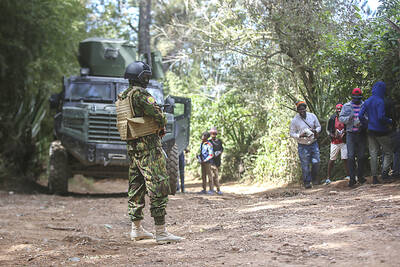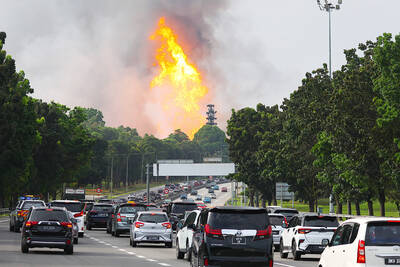A young Tibetan monk set himself on fire in southwestern China before being beaten and dragged away by Chinese security forces, a rights group said yesterday.
Named as Lobsang Tsultrim, aged 20, the monk raised a fist — a gesture of defiance used by Tibetans who accuse China of abuses — before setting himself alight on Friday, Free Tibet said in a statement.
The incident happened by the Kirti monastery in Aba prefecture, Sichuan Province, where many Tibetans live, the London-based group said.
The attempted suicide was confirmed by Radio Free Asia, but the propaganda department of Aba refused to comment when contacted yesrterday.
In the past year, about 30 Tibetans — many of them young Buddhist monks and nuns — have set themselves on fire to protest against Chinese rule.
In the latest incident, witnesses quoted by Radio Free Asia and Free Tibet said security forces hit the monk while he was alight, before extinguishing the flames and taking him, still alive, to an unknown destination.
Many Tibetans in China complain of religious repression, as well as a gradual erosion of their national culture, which they blame on a growing influx of majority Han Chinese in areas where they live.
However, China denies this and says Tibetans are leading better lives than ever before, thanks to huge investment in infrastructure, schools and housing.
Beijing has accused overseas organizations of seeking independence for Tibet and blamed the Dalai Lama — Tibet’s exiled spiritual leader — for the unrest.
Tibet’s government-in-exile said more than 200 people died in the March 2008 unrest, but China denies that account, saying there were 21 deaths and that “rioters” were responsible.
Authorities have mounted a heavy security presence in Tibetan-inhabited areas in response to the self-immolations and sometimes deadly clashes between protesters and police in recent months.

DITCH TACTICS: Kenyan officers were on their way to rescue Haitian police stuck in a ditch suspected to have been deliberately dug by Haitian gang members A Kenyan policeman deployed in Haiti has gone missing after violent gangs attacked a group of officers on a rescue mission, a UN-backed multinational security mission said in a statement yesterday. The Kenyan officers on Tuesday were on their way to rescue Haitian police stuck in a ditch “suspected to have been deliberately dug by gangs,” the statement said, adding that “specialized teams have been deployed” to search for the missing officer. Local media outlets in Haiti reported that the officer had been killed and videos of a lifeless man clothed in Kenyan uniform were shared on social media. Gang violence has left

US Vice President J.D. Vance on Friday accused Denmark of not having done enough to protect Greenland, when he visited the strategically placed and resource-rich Danish territory coveted by US President Donald Trump. Vance made his comment during a trip to the Pituffik Space Base in northwestern Greenland, a visit viewed by Copenhagen and Nuuk as a provocation. “Our message to Denmark is very simple: You have not done a good job by the people of Greenland,” Vance told a news conference. “You have under-invested in the people of Greenland, and you have under-invested in the security architecture of this

A fire caused by a burst gas pipe yesterday spread to several homes and sent a fireball soaring into the sky outside Malaysia’s largest city, injuring more than 100 people. The towering inferno near a gas station in Putra Heights outside Kuala Lumpur was visible for kilometers and lasted for several hours. It happened during a public holiday as Muslims, who are the majority in Malaysia, celebrate the second day of Eid al-Fitr. National oil company Petronas said the fire started at one of its gas pipelines at 8:10am and the affected pipeline was later isolated. Disaster management officials said shutting the

Japan unveiled a plan on Thursday to evacuate around 120,000 residents and tourists from its southern islets near Taiwan within six days in the event of an “emergency”. The plan was put together as “the security situation surrounding our nation grows severe” and with an “emergency” in mind, the government’s crisis management office said. Exactly what that emergency might be was left unspecified in the plan but it envisages the evacuation of around 120,000 people in five Japanese islets close to Taiwan. China claims Taiwan as part of its territory and has stepped up military pressure in recent years, including